46 ST70+ User Reference Manual
Rudder damping
If the autopilot is ‘hunting’, i.e. continuously moving the steering backwards and
forwards by small amounts, use the Setting rudder damping procedure in
Chapter 3:Setup Information to improve autopilot stability.
Setting AutoTrim
AutoTrim determines how quickly the autopilot applies ‘standing helm’ to correct for
trim changes, caused, for example, by changes in the wind load on the
superstructure, or an imbalance of engines.
Increasing the AutoTrim level reduces the time the autopilot takes to return to the
correct course, but makes the boat less stable. If the autopilot:
• Gives unstable course keeping and the boat ‘snakes’ around the desired course,
decrease the AutoTrim level.
• Hangs off course for excessive periods of time, increase the AutoTrim level.
If necessary, use the Setting AutoTrim procedure in Chapter 3:Setup Information to
improve autopilot performance.
2.6 After commissioning
When the dockside setup and open water calibration have been completed, and you
have returned to normal operation, your ST70+ instrument and autopilot systems are
ready for use. Refer to the ST70+ Operating Guide for instructions on how to use
ST70+ on a day-to-day basis.
Before using the autopilot system you should thoroughly familiarize yourself with its
functions and ensure you know how to use it correctly. It is important to:
• Read the ST70+ Operating Guide.
• Carry out trial runs under autopilot control, in familiar waters away from other
vessels and obstructions
CAUTION: Any additional changes you make to your system settings may
require you to repeat the calibration process.
EMC Conformance
Always check the installation before going to sea to make sure that it is not affected by
radio transmissions, engine starting etc.
To do this:
1. Turn on all transmitting equipment (radar, VHF radio etc.).
2. Check that all electronic systems are unaffected by the transmitting equipment
(e.g. without undue interference).
85024_1.book Page 46 Tuesday, January 27, 2009 11:31 AM

